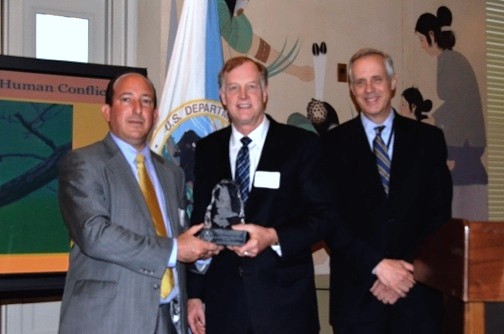 By Andrea Brennan
By Andrea Brennan
In May 2014, the U.S. Department of Agriculture Animal and Plant Health Inspection Service, Wildlife Services received the 2014 Presidential Migratory Bird Federal Stewardship Award from U.S. Fish and Wildlife Services Council for the Conservation of Migratory Birds. APHIS WS was recognized for ten years of managing migratory animals, especially birds of prey, near high-risk locations such as airports.
Between 2004 and 2013, APHIS WS successfully live-trapped and relocated more than 13,700 individual raptors, representing at least 32 different species, away from an environment where the birds and other resources were at risk, such as at an airport. About five percent (more than 650 individual birds), were species of concern such as short-eared owls, golden eagles, and Mississippi kites. Pictured: Michael Begier (National Coordinator, Airport Wildlife Hazards Program at USDA APHIS WS), William Clay (Deputy Administrator of APHIS WS), and Stephen Guertin (Deputy Director for Policy, U.S. Fish and Wildlife Services). [photo courtesy of U.S. Fish and Wildlife Service]
Wildlife Services has also conducted numerous research projects throughout the country using both traditional bird banding and cutting-edge satellite telemetry technologies. The research provided critical information needed to increase the effectiveness of raptor relocation used to resolve conflict situations, identified patterns on how some raptors use airports, and quantified the risk that migrating raptors pose to military training flights. Although APHIS has used the study findings predominantly to reduce bird-aircraft strikes at civil and military airfields, the information and innovative methods are being used to evaluate and manage other human-raptor conflict situations, such as wind energy facility development.
“It is gratifying that this council of concerned federal agencies has recognized Wildlife Services’ efforts and commitment to safeguarding migratory bird conservation while conducting its assigned mission to safeguard resources,” said William Clay, Deputy Administrator of Wildlife Services. “This important program exemplifies the agency’s efforts to resolve human health and safety issues and further the conservation of our nation’s natural resources, especially migratory birds, through science-based management efforts and cutting edge research in the Wildlife Services program.”
The Department of the Interior Fish and Wildlife Services Presidential Migratory Bird Federal Stewardship Award annually recognizes a single project or action conducted by or in partnership with a federal agency that focuses on migratory bird conservation. Actions may involve reducing existing or potential adverse impacts to migratory birds and their habitats, restoring or enhancing migratory bird habitat, and incorporating conservation of migratory birds and their habitat into agency plans, guidance, or other activities. The partner agency should demonstrate leadership in inspiring others to further migratory bird conservation.
APHIS Wildlife Services relocates more than one thousand raptors every year, stated a representative of the program. “WS biologists do this every day: from moving osprey from seaside Air Forces bases to the Midwest in order to re-establish populations, to relocating state-endangered owls to friendlier habitat.”



